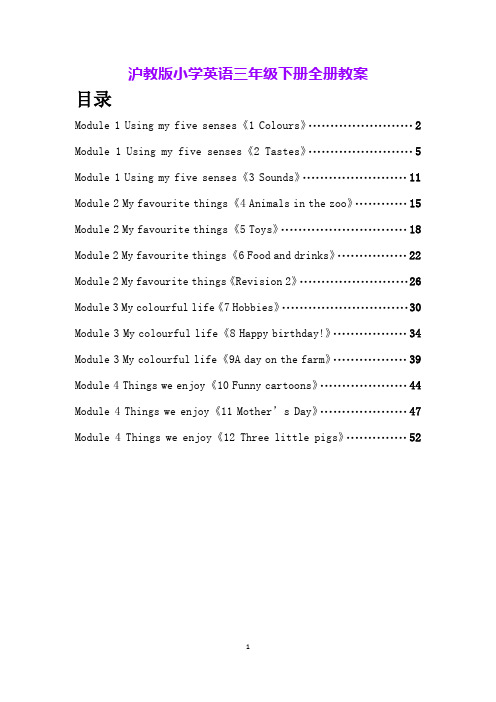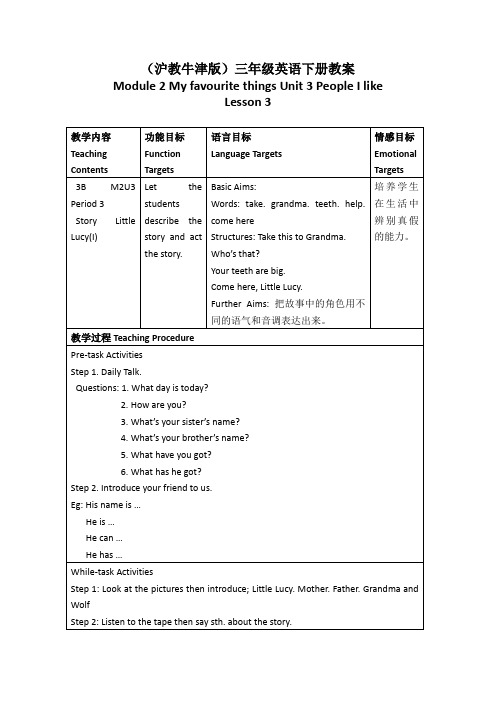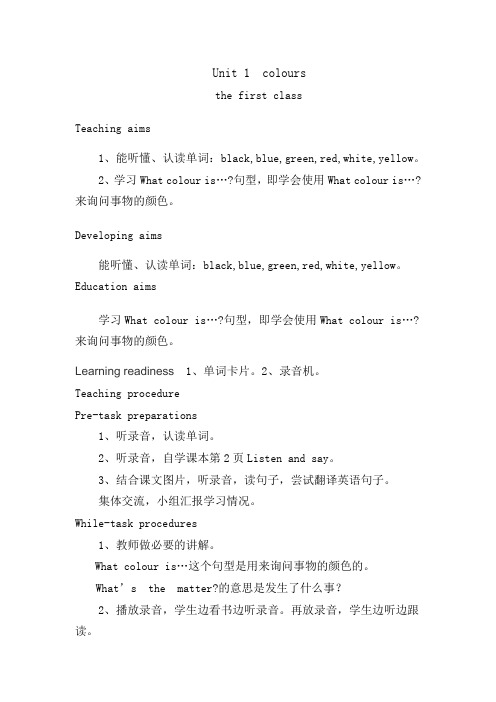上海处语教育出版社小学三年级英语第二学期教案What do we do in the spring
- 格式:docx
- 大小:22.45 KB
- 文档页数:3


(沪教牛津版)三年级英语下册教案Module3Unit 3 The seasonsThe second period一、主要新授内容(New contents)Vocabulary: autumn, winter, wind, blow, scarves, gloves Structures: It is ____. It’s not____.In autumn/winter, we can see……二、学习目标(Learning objectives)1. 通过介绍秋冬两季的特征,培养学生一定的观察能力和表述能力。
2.学习.autumn, winter, wind, blow, scarves, gloves的正确发音。
三、教学建议(Teaching Suggestion)1、任务前期准备阶段(Pre-task preparation section)Activity 1 (Warming-up)1.教学辅助:录音机图片2.活动过程(Process)Activity 2 ( Daily talk )1.教学辅助:图片2.活动过程(Process)2.任务中期实施阶段(While-task procedure section)Activity 1 (Introduction)1、教学辅助(Aids) 图片2、活动过程(Process)Activity 2 (Read and spell)1、教学辅助(Aids) 多媒体2、活动过程(Process)Activity 3 (Introduction)1、教学辅助(Aids) 录音机或媒体2、活动过程(Process)Activity 4 (Read and spell)1、教学辅助(Aids) 多媒体2、活动过程(Process)Activity 5 (Game)1、教学辅助(Aids) 图片2.活动过程(Process)3. 任务后期完成阶段(Post-task activity section)Activity 1( Read the text)1、教学辅助(Aids) 图片书本2.活动过程(Process)Activity 2 (Game)1、教学辅助(Aids) 图片2.活动过程(Process)Activity 3 (Story)1、教学辅助(Aids) 多媒体2.活动过程(Process)Activity 4(Assignment)1、教学辅助(Aids):2.活动过程(Process)内容总结。

3B M1 Unit 1 Seeing and hearingI. 单元分析一、基本要求:1、能听说读写:can, can’t, aeroplane, bus(buses), ship, car, hear, see词汇。
2、能听说读:listen(to), look at, There is…, What else…, children(chilled), they,them, an aeroplane, some等词汇。
3、能掌握ch-[tʃ]的发音规则:chick, chair。
4、能掌握并运用What can you hear/see? I can hear/see…What colour can you see?表达相关信息。
5、能掌握并运用一般疑问句Can you…? Yes,I can/.No,I can’t.询问并获得信息。
6、能掌握并运用… and…, … but…的句型。
7、熟悉作spinner的过程、顺序。
8、欣赏并学唱儿歌I hear raindrops.二、相关旧知:1B:bicycle ridewhat do you see?I see… 和what do you hear? I hear…2B:train, bus, car, van , bicycle, ship.What can you hear? I can hear…; ….can…, …can’t…三、发展性要求:(可以选择性运用)1 、能选择性听说读下面的单词、词组和句子:circle 圆圈toothpick牙签spin旋转spinner转盘use使用raindrop雨滴fall(ing) down落下pitter-patter雨滴声by the window窗边Charlie查理Charlie has…, Carlie and his chick are sitting on the chair.2. 文本(1)A song: I hear raindropsI hear raindropsI hear raindropsFalling downFalling downPitter-patter, raindropsPitter-patter, raindropsFalling downFalling down(2). A rhymeCharlie has a chick.Charlie has a chair.Charlie and his chickAre sitting on the chair.(3) Mini-dialoguePeter: What can you see in the sky, Kitty?Kitty: I can see some…Peter: How many…are there?Kitty: There are…Peter: What colour are..?Kitty: They are…(4) A passage:It is rainy today. Alice and her brother Tom can’t go out and play. They can only stay at home. They are both standing by the window. They can hear raindrops. And they can see many cars and buses in the street. Alice likes listening to the raindrops, but Tom doesn’t. He likes watching the busy cars.四、情感与人文:善于观察、聆听身边的事物,热爱生活。

沪教版小学英语三年级下册全册教案目录Module 1 Using my five senses《1 Colours》 (2)Module 1 Using my five senses《2 Tastes》 (5)Module 1 Using my five senses《3 Sounds》 (11)Module 2 My favourite things《4 Animals in the zoo》 (15)Module 2 My favourite things《5 Toys》 (18)Module 2 My favourite things《6 Food and drinks》 (22)Module 2 My favourite things《Revision 2》 (26)Module 3 My colourful life《7 Hobbies》 (30)Module 3 My colourful life《8 Happy birthday!》 (34)Module 3 My colourful life《9A day on the farm》 (39)Module 4 Things we enjoy《10 Funny cartoons》 (44)Module 4 Things we enjoy《11 Mother’s Day》 (47)Module 4 Things we enjoy《12 Three little pigs》 (52)Module 1 Using my five senses《1 Colours》1教学目标1.能听懂、韧认读单词black, blue, green, red, white, yellow.2.学习句型What colour is your ball?及其回答It's red and white.3.灵活运用所学句型询问身边事物的颜色。
2学情分析本课时学习两个栏目。


Unit 1 coloursthe first classTeaching aims1、能听懂、认读单词:black,blue,green,red,white,yellow。
2、学习What colour is…?句型,即学会使用What colour is…?来询问事物的颜色。
Developing aims能听懂、认读单词:black,blue,green,red,white,yellow。
Education aims学习What colour is…?句型,即学会使用What colour is…?来询问事物的颜色。
Learning readiness 1、单词卡片。
2、录音机。
Teaching procedurePre-task preparations1、听录音,认读单词。
2、听录音,自学课本第2页Listen and say。
3、结合课文图片,听录音,读句子,尝试翻译英语句子。
集体交流,小组汇报学习情况。
While-task procedures1、教师做必要的讲解。
What colour is…这个句型是用来询问事物的颜色的。
What’s the matter?的意思是发生了什么事?2、播放录音,学生边看书边听录音。
再放录音,学生边听边跟读。
3、学生自主朗读,教师作必要的指导,请个别学生上讲台朗读。
Post-task activities1、听写单词black, blue, green,red, white, yellow。
2、将下列单词组合成完整的句子。
colour, is, What, ball, your__________________________Is, red, It__________________________The second classTeaching aims1、能听懂、认读单词:black,blue,green,red,white,yellow。
2、学习What colour is…?句型,即学会使用What colour is…?来询问事物的颜色。
沪教版小学英语三年级下册全册教案沪教版小学英语三年级下册全册教案目录Module 1 Using my five senses《1 Colours》 (2)Module 1 Using my five senses《2 Tastes》 (5)Module 1 Using my five senses《3 Sounds》 (11)Module 2 My favourite things《4 Animals in the zoo》 (15) Module 2 My favourite things《5 Toys》 (18)Module 2 My favourite things《6 Food and drinks》 (22)Module 2 My favourite things《Revision 2》 (26)Module 3 My colourful life《7 Hobbies》 (30)Module 3 My colourful life《8 Happy birthday!》 (34)Module 3 My colourful life《9A day on the farm》 (39)Module 4 Things we enjoy《10 Funny cartoons》 (44)Module 4 Things we enjoy《11 Mother’s Day》 (47)Module 4 Things we enjoy《12 Three little pigs》 (52)Module 1 Using my five senses《1 Colours》1教学目标1.能听懂、韧认读单词black, blue, green, red, white, yellow.2.学习句型What colour is your ball?及其回答It's red and white.3.灵活运用所学句型询问身边事物的颜色。
2019-2020年三年级英语下册 MODULE3 unit2教案沪教牛津版【单元分析(UNIT ANALYSIS)】一、学习目标(LEARNING OBJECTIVES)知识目标:1. 语音:掌握元音字母“U”在非开音节中的发音/ju:/2. 词汇:(1)认识形容“noises”的形容词loud,quiet以及掌握生活中发出各种声音的物体的名称,如:drill, aeroplane,boat, bus, car, telephone,raindrop, lorry, waves等名词。
(2)学会区分指示代词“this/that/these/those”在句子中的不同用法。
3. 句型:(1)复习巩固特殊疑问句“What can you hear? What do you like?”以及一般疑问句“Do you like…? Is this…?”及其肯定/否定回答。
(2)学会运用新句型What’s that noise? Is this noise loud/quiet? 进行流利的问答,并能表达自己对各种声音的喜好。
能力目标:1. 通过巩固学习使学生对‘Wh- question’的用法有更进一层地了解和掌握。
2. 通过巩固学习What ’s that noise? Is this noise loud/quiet? 相关的问答,使学生对能发出声音物体的名称,描述声音的形容词的运用和理解进一步加深。
3. 通过学习,使学生能够准确运用自己已有的语言能力对自然界的部分现象进行简单描述。
情感目标:通过学习使学生热爱自己生活的环境,养成细心观察生活的好习惯。
二、教学资源(TEACHING RESOURCES)1.现代技术支撑(I.P. support)电脑多媒体辅助设备2、视听材料辅助(Audio-visual aids)图片录音机3、学习材料(Materials)学生用书配套练习册活页资料设计的练习和表格三、课时划分(PERIOD DIVISION)Unit2建议分二课时完成。
Unit 9 They played a guessing game【教学目标】“四会”单词:played/walked/looked/smelled/asked/answered/laughed/shouted/pointed to/yesterday“三会”句型:They played a guessing game yesterday.【教学重难点】重点:1.单词的认读。
2.功能句的理解。
难点:句型:They played a guessing game yesterday.【课时安排】1课时【教学准备】多媒体,图片【教学过程】Step 1 Warming up and greetingDaytime greeting to every student.Step 2 Presentation1. Show the picture of "play/walk/look/smell/ask/talked/answer/laugh/shout/point to" and ask students to do the action. Then write down the words on the board.2.Ask Ss to read the words after the tape. And then point one of the words and ask them to say it out in race.3. Add "ed" at the end of the verbs and ask Ss to guess the meanings and T explains the words.Step 3 ReadingFirst reading: ask Ss to read the passage and find out the words that they don't know. Then Texplains the words that they don't know.Second reading: ask Ss to listen to the tape and read it again and think about the following questions:(1) Where were Tony, Jenny and Gogo yesterday?(2) What did they do?Then ask Ss to answer the questions.Third reading: role play.Step 4 Sentence structures learningAsk Ss to look at "Gogo structure" part and to find out the rules of the sentences, after that T explains them.Step 5 Practice1. Do "complete the sentences"2. Finish "look and write"3. Pair work—"play a guessing game"Step 6 SummaryAsk a student to summary the content we learned today.Step 7 Homework1.Listen to the radio.2.Review the new words and sentences.3.Read the text【板书设计】Unit 9 They played a guessing gameThey played a guessing game yesterday.。
沪教版三年级英语教案(最新版)编制人:__________________审核人:__________________审批人:__________________编制学校:__________________编制时间:____年____月____日序言下载提示:该文档是本店铺精心编制而成的,希望大家下载后,能够帮助大家解决实际问题。
文档下载后可定制修改,请根据实际需要进行调整和使用,谢谢!并且,本店铺为大家提供各种类型的经典教案,如幼儿教案、小学教案、初中教案、高中教案、大学教案、其他教案等等,想了解不同教案格式和写法,敬请关注!Download tips: This document is carefully compiled by this editor.I hope that after you download it, it can help you solve practical problems. The document can be customized and modified after downloading, please adjust and use it according to actual needs, thank you!In addition, this shop provides you with various types of classic lesson plans, such as preschool lesson plans, elementary school lesson plans, junior high school lesson plans, high school lesson plans, university lesson plans, other lesson plans, etc. If you want to learn about the format and writing of different lesson plans, stay tuned!沪教版三年级英语教案英语学习要千方百计地给学生创造机会,让每个学生多讲多练,培养英语学习的兴趣。
Unit 2 What do we do in the spring?
【教学目标】
“四会”单词:
spring/ summer/autumn/fall/winter/wear thick clothes/go to the park/swim in the sea/play on the beach/ride a bike/listen to…/put on/ice cream
“三会”句型:
What do you do in the spring?
-We go to the park and listen to the birds.
【教学重难点】
重点:
1.单词的认读。
2.功能句的理解。
难点:
句型:
What do you do in the spring?
-We go to the park and listen to the birds.
【课时安排】
1课时
【教学准备】
多媒体,图片
【教学过程】
Step 1 Warming up and greeting
Daytime greeting to every student.
Step 2 Presentation
1.Show the pictures of "spring/ summer/autumn/fall/winter" to the students, and ask them what they can see in the pictures. After Ss describing the pictures. Write down the words on the board.
2.Ask Ss to read the words after the tape. And then show one of the pictures and ask Ss to say out the word in competition.
3. Lead students to think about something about the four seasons and show the phrase pictures of thick clothes/sea/beach/bike/ice cream.
Step 3 Reading
First reading: ask Ss to read the passage and find out the words that they don't know. Then T explains the words that they don't know.
Second reading: ask Ss to listen to the tape and read it again and think about the following questions:
(1) What do we do in the spring?
(2) What do we do in the summer?
(3) What do we do in the autumn?
(4) What do we do in the winter?
Then ask Ss to answer the questions.
Third reading: think about more activities we will do in different seasons.
Step 4 Sentence structures learning
Ask Ss to look at "Gogo structure" part and to find out the rules of the sentences, after that T explains sentences.
Step 5 Practice
1. Do "join the dots"
2. Finish "say and write"
3. Pair work—"ask and answer"
4. Finish "read and learn" part.
Step 6 Summary
Ask a student to summary the content we learned today.
Step 7 Homework
1.Listen to the radio.
2.Review the new words and sentences.
3.Read the text
【板书设计】
Unit 2 What do we do in the spring?
What do you do in the spring?
-We go to the park and listen to the birds.。